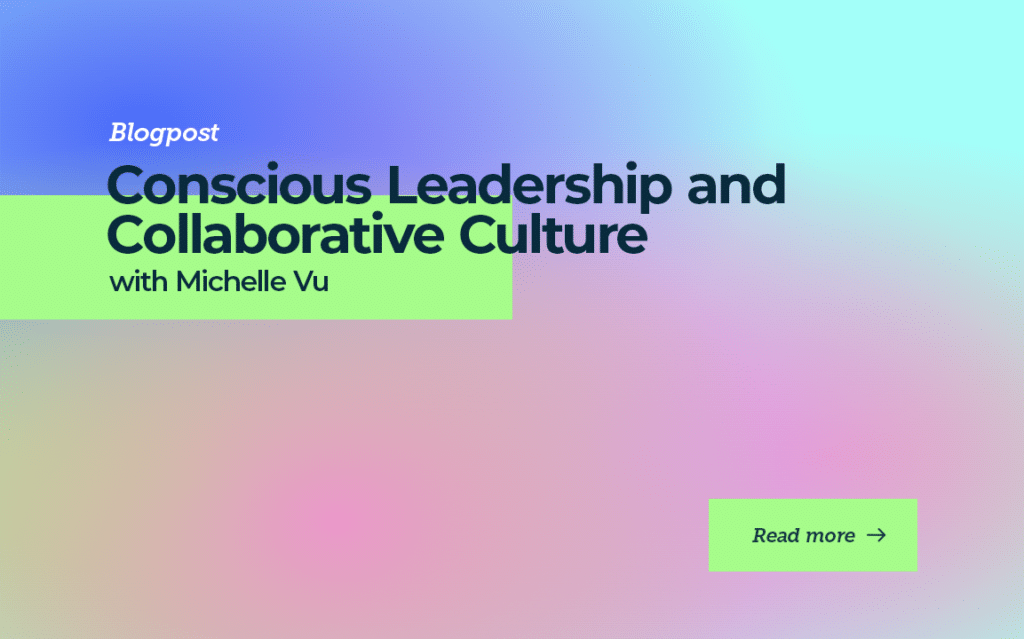Conscious Leadership and Collaborative Culture with Michelle Vu

Michelle Vu’s Origin Story
Michelle’s sales career began at age 15 with a role in her father’s friend’s company, where she filled out surveys. This path led her through several positions, including door-to-door office supply sales and work at a car dealership during college.
Her early sales experiences, especially direct customer interactions, were powerful lessons in handling rejection and resilience. Learning to face a “no” proved crucial in shaping her professional growth.
By 24, Michelle took on her first leadership role. She quickly identified the importance of human connection and the role of positive culture in team success. To foster this, she introduced creative team-building exercises, such as having members describe others positively and nurturing a supportive team environment.
These experiences deeply influenced her understanding of leadership and the necessity of a strong team culture.
Peak Performance to Valley: Lessons Learned
Michelle Vu’s sales journey has seen both triumphs and trials. Her proudest achievement was selling paper to a butcher during her door-to-door sales stint, underscoring her perseverance and skill.
Conversely, a significant setback was losing a crucial renewal, despite satisfying all client needs. The company’s decision to reallocate its budget resulted in deep disappointment for Michelle.
Personal Strategies for Motivation
Michelle devised a strategy to maintain positivity in an industry of fluctuating fortunes. She created a “warm, fuzzy folder” on her laptop, a positive feedback and recognition collection. This folder is a motivational tool, helping her stay focused and resilient during challenging times.
The Importance of a Supportive Leader
During difficult periods, her leader’s understanding and support were pivotal. Taking a break was recommended, giving her space to regain her strength. This empathetic approach profoundly influenced Michelle and is a leadership style she strives to emulate with her team.

Intentionality in Creating Culture
Creating a positive culture in sales is a focal point in Michelle’s leadership approach. It’s not just about celebrating the highs; providing the necessary support during the lows is equally essential.
A leader must show understanding and empathy during a team member’s challenging times. Similarly vital is recognizing personal achievements, which can be leveraged as a self-motivation tool.
Building Personal and Team Resilience
Michelle’s practice of keeping a folder of accomplishments and positive feedback is more than just a motivational tool; it’s a strategy to build resilience.
In an industry where setbacks are part and parcel of the job, the ability to bounce back is essential. This approach strengthens Michelle’s resilience and can serve as a valuable technique for the entire team, fostering a culture of strength and determination.
Misconceptions about Building Culture
For new leaders, culture building often equates to organizing social events. However, this is a misconception. Culture isn’t about peripheral activities but about day-to-day operations and team decisions.
“Culture is About What You Allow”
Building a positive culture goes beyond fun activities. It’s about what behaviors are tolerated and what norms are set. Addressing or ignoring certain behaviors within the team sets the tone for what’s acceptable, thereby shaping the culture.
Creating a Conducive Environment for Culture
Michelle emphasizes that a sales leader’s responsibility is creating an environment where the team can thrive. This involves removing obstacles, encouraging open communication, and ensuring everyone feels supported. The leader’s role is to facilitate an environment for collective success beyond individual quotas and goals.

Creating Culture vs. Creating an Environment for Culture to Grow
A key aspect of Michelle’s leadership involves understanding her team members individually. Building an effective team culture isn’t a one-size-fits-all approach. It’s about understanding each individual’s unique motivations and work styles, with everyone’s success contributing to the team’s achievement.
The Impact of Remote Work on Team Culture – Navigating the Challenges
The shift to remote work during the pandemic posed significant challenges for team culture. Practices like frequent check-ins and virtual happy hours initially worked but eventually lost effectiveness. This led Michelle to develop innovative methods of engagement, such as walk-and-talk meetings to combat ‘Zoom fatigue’ and encourage flexibility in work schedules, promoting morale and productivity.
Balancing Work-Life Commitments – Prioritizing Well-being
Michelle Vu emphasizes work-life balance, especially in remote work setups. She advocates open discussions about personal commitments, leading by sharing her own. This practice fosters transparency and respect for individual needs within the team, creating an environment where work doesn’t overshadow personal life, thereby fostering a healthier, more productive team.
The 6 Pillars of Team Culture
If you’re looking foster a healthy and productive team culture, it’s essential to have an actionable strategy in place.
Drawing from her years of experience and inspiration from her past mentors and colleagues, Michelle developed a systematic approach called the 6 Pillars of Team Culture. These pillars encompass the core values and behaviors that can guide a team toward an enriching and fulfilling work experience.
They include: Knowing Their Why, Having a Voice, Breaking Down Barriers, Equity, Celebrating Wins, and Establishing Traditions.
1- Knowing Their Why
A critical aspect of fostering a strong team culture is understanding what motivates each member. As Michelle notes, perseverance in sales requires recognizing what drives each team member, whether personal goals or passion for their work.
Inspired by Simon Sinek’s concept, “Start With Why,” Michelle encourages team members to share their unique ‘why.’ Recognizing that motivations can change over time, she proposes an annual revisit, starting with the leader, to foster transparency and vulnerability.
Incorporating the ‘Why’ in Regular Conversations
Understanding ‘why’ shouldn’t be a one-off event but a recurring theme in team discussions. At G2, Michelle’s organization, the ‘why’ becomes crucial in quarterly conversations about professional development, even extending to personal goals.
Vision boards, used to visualize motivations and goals, make these aspirations tangible. Midway through the year, Michelle encourages sharing these boards to track progress, foster accountability, and reaffirm commitment to personal goals.
Making Sense of the ‘Why’
Understanding each team member’s ‘why’ helps contextualize professional objectives. For instance, achieving a sales quota isn’t merely reaching a target; it becomes a stepping stone towards a broader personal goal, making the work more meaningful.
Like all leaders, Michelle has made assumptions and mistakes. Initially, she presumed that commissions primarily motivated her team members. However, through open communication, she discovered motivations as diverse as her team members, a realization that shaped her leadership approach.
2- Ensuring Everyone Has a Voice
Michelle underscores the importance of making everyone on the team feel acknowledged. Leaders can foster an environment where all feel valued by understanding individual preferences and integrating them into the team’s operation. These considerations contribute to a team where everyone believes their voice matters.
Encouraging Feedback: The Power of Open Communication
Michelle adopts a proactive strategy to solicit feedback. Each quarter, she circulates anonymous feedback forms covering various topics, giving everyone the chance to voice their thoughts and ideas. This practice instills a sense of ownership and participation in every team member.
Anonymous Feedback: A Tool for Inclusivity
Anonymous feedback promotes inclusivity and openness, removing the fear of repercussion or judgment that could inhibit honest communication. This approach leads to more genuine and actionable feedback.
Constant Feedback: The Backbone of Continuous Improvement
Feedback at Michelle’s workplace is not limited to quarterly surveys; it’s ongoing. This approach ensures the team is continually evolving and promotes a culture of transparency.
Personalizing Work Processes: Tweaking for Team Preferences
Michelle believes in customizing team operations to suit the members’ preferences better. This philosophy is not about involving everyone in every decision but about making adjustments that make everyone more comfortable in their roles.
Removing Political Barriers: Anonymous for Honest Preferences
Anonymous feedback forms also serve to eliminate potential political influences in team decisions. Whether it’s about rescheduling a meeting or implementing a new process, anonymity ensures honesty, transparency, and comfort in sharing views.
3- Breaking Down Barriers
Michelle believes in overcoming barriers to cultivate a collaborative culture, fostering an environment of vulnerability, openness, and understanding.
She encourages team members to express their concerns and needs without hesitation. An innovative practice she employs involves soliciting encouragement, anecdotes, and photos from team members’ loved ones during high-stress periods, like the fiscal year-end.
The Art of Personalizing Team Connections
Michelle’s unique approach extends to obtaining personal anecdotes and pictures from family members, creating deeper team connections. Sharing these personal stories and photos uncovers intriguing facets of team members’ lives, strengthening their unity and camaraderie. This practice has become a treasured team tradition.
Impact of Breaking Down Barriers
Breaking down barriers fosters stronger team connections. Understanding each other’s backgrounds and motivations cultivates greater empathy, leading to a more collaborative and supportive work environment and improved productivity.
Breaking barriers extends beyond open communication; it entails a deeper understanding of each other’s humanity. This approach, although unconventional, has a significant impact on cultivating a collaborative culture.
4- Equity
Shifting the focus from hiring for “culture fit” to “culture contribution,” Michelle explains that this approach helps break free from the constraints of stereotypical thinking, allowing the team to benefit from diverse experiences and insights. She emphasizes that each individual has unique offerings that can enrich the company culture.
Drawing a line between equality and equity, while the former involves providing everyone with the same resources, the latter addresses individual needs to achieve the same results. Michelle emphasizes the importance of acknowledging unconscious biases in the hiring process and continually educating oneself and one’s team on these biases.
Actionable tips to counter bias in the hiring process:
- Use standardized interview questions for all candidates. Even if a company lacks internal resources to promote diversity and fight prejudice, it can partner with external networks.
- Use mentors and leverage peers’ networks to avoid a homogenous team, particularly for startups that might not have resources for comprehensive internal diversity initiatives.
5- Celebrating victories
Michelle explains that celebrating victories, while seemingly straightforward, requires a thoughtful understanding of team members’ preferences. She notes that not everyone prefers public acknowledgment—some favor one-on-one recognition. To respect such preferences, leaders should inquire about them during initial discussions and consistently adhere to them. She insists on communicating this information to senior leadership, ensuring recognition aligns with individuals’ comfort levels.
Consistent recognition is key, she adds. Michelle emphasizes the importance of setting clear parameters for achievements warranting recognition and suggests utilizing dedicated communication channels like Slack.
Michelle also values the concept of ‘Big, Hairy, Audacious Goals’ (BHAGs). She fondly recalls a team reward—a boat ride in Chicago—following the attainment of a significant goal. Sharing these ambitious goals with higher-ups can cultivate an atmosphere of encouragement and shared enthusiasm, bolstering the team’s drive to achieve them.
Furthermore, Michelle believes in the power of celebrating even small victories. She contends that these acknowledgments create lasting, positive memories for team members, offering motivation during less successful periods.
6- Establishing traditions
Michelle believes that just like families have their traditions, work teams should have their own, considering that we spend a significant part of our lives with colleagues. Establishing traditions creates a sense of predictability and comfort in a sales environment, which is often unpredictable.
These traditions could involve how the team takes feedback, how it operates, or even its mission statement. They form the bedrock of the team’s identity and culture. Michelle emphasizes that the team owns these traditions, not just the leader, and these practices should be communicated to prospective members even during the interview process.
This approach reveals that traditions can be as diverse and unique as the teams that form them and can significantly contribute to cohesion and identity. Combining small acknowledgments and big celebrations, personal interactions, and group activities can create a work environment that feels comfortable, predictable, and rewarding.
Balancing Leadership Responsibilities and Implementing the Six Pillars
Michelle, managing two teams across two markets, expertly executes her six-pillar strategy through effective delegation and trust in her leadership team. She advocates for empowering leaders within the team, not controlling everything herself but guiding a cohort of leaders to manage their respective teams. This strategy ensures the six pillars permeate the organization, tailored to each team’s unique needs.
When applied to leaders, the six pillars focus more on understanding each leader’s individual motivations, goals, and career progression plans rather than wider team dynamics. This indicates the flexibility of Michelle’s approach, suggesting the six pillars are adaptable to various leadership contexts.
As for time commitment, Michelle says it’s as much as necessary. The six pillars serve as a foundation, influencing her management approach while adapting to daily business changes. Some elements are time-specific, while others come into play as needed, depending on circumstances.
Michelle’s fluid approach may not appeal to those seeking a fixed leadership blueprint. However, it underscores that effective leadership is not a ‘one-size-fits-all’ solution but a responsive, ongoing process.
When adopting Michelle’s strategies, it’s crucial not to overload your team, especially if it’s new. Start with feedback, understand the team’s current state and needs, and then gradually incorporate other aspects of her approach. This emphasizes that successful leadership is as much about flexibility and responsiveness as it is about adhering to proven strategies.
Conclusion
Michelle Vu’s leadership style, encapsulated by her six pillars, highlights the importance of empathy, inclusivity, and adaptability in fostering a robust team culture. She emphasizes understanding individual motivations, ensuring every voice is heard, celebrating victories, and balancing responsibilities in unique, resonant ways. It’s about achieving goals and cultivating an environment where each member can thrive. This flexible, personalized approach provides invaluable insights for leaders building a vibrant, collaborative, and productive team culture.
NO TIME TO READ?
Listen On:




